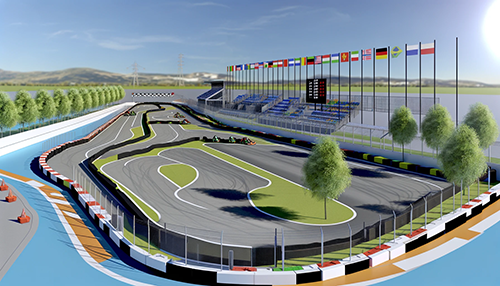 Much as automobile racing began in the early 1900s and has continue up to the present spreading out into many distinct variations, concession go-karts evolve into many variations, but over a much shorter period.
Much as automobile racing began in the early 1900s and has continue up to the present spreading out into many distinct variations, concession go-karts evolve into many variations, but over a much shorter period.
When this writer began designing go-kart tracks in 1990, concession go-karts were evolving from their early infancy. Historically the exact origin of the modern concession go-kart is forever shrouded in mystery. Some writers credited an individual in the early 1960s as having created the rough configuration of go-karts that have proliferated since that time.
Unregulated Jungle:
The early karting industry was a highly unregulated jungle. Few states even had vague, minimum design or safety standards for go-karts or go-kart tracks, and most of those that did, had vague, misinformed or not even based on reality.
In the 80s and early 90s a number of States had developed basic criteria to evaluate proposed go-kart track construction plans and specific permitting procedures. Unfortunately these were often prepared by bureaucrats with little or no experience or knowledge concerning actual design, safety and operating procedures. Many states had no specific criteria for track design and some didn’t have any requirements. This resulted in a wide range of track designs, some of which were well designed and others’ disasters waiting to happen.
The industry had a wide variety of go-karts on the market at that time, with some as wide as 5 feet and a variety of configurations. Some had almost no chassis, others had flexible plastic bodies, primitive steering and brakes that pressed against the tires. Many had no roll bars or just loops of pipe bolted to the floor panels and, not all had seat belts or wraparound bumpers.
Concession go-kart tracks in the US ranged in length from 100 feet to more than 8,000 feet. Surfaces spanned dirt, gravel, sand, asphalt and Portland cement. Many had no safety barriers defining the track width. Some tracks had automobile tires mounted vertically, buried half way, loose automobile and tractor tires lying randomly and some loosely chained together, sand filled automobile and tractor tires lying loosely, telephone poles and 8” x 8” beams forming the edge.
This writer visited one paved track in Phoenix that had a 24 “ vertical concrete barrier wall, with go-karts that had go-kart tires mounted horizontally at the front corners to redirect karts away from the wall. In Michigan I observed a track attendant throw an automobile tire at a kart to stop it. In Pennsylvania I visited a track where a young girl was severely burned because the gas cap on the fuel tank was not fastened or even replaced causing gasoline to spill on to the hot engine and igniting. This happened under a bridge and if another karter hadn’t pulled her from the kart, she would have died. Only one attendant and he had no line of sight to the area of the accident. The day I visited the track with a client the only attendant was sitting down reading a book while riders were on the track. These were everyday occurrences in the 80s and early 90s.
Unfortunately the industry experienced a number of fatalities during the early years due to high speeds, lack of seat belts, roll bars, ineffective brakes and steering, lack of effective track safety barriers, poor kart and track design, primitive lighting, lack of remote kart controls, untrained track attendants and lack of effective instructions to the drivers.
Some Unsafe Driving Practices:
On one occasion in 1993, while visiting a track in Wisconsin I witnessed a couple each placing children on their laps in separate karts with the assistance of the park’s When I protested that doing so was endangering the lives of the children, all three told me to mind my own business and continued with what they were doing. Fortunately there were no collisions and the children were fine. Unfortunately this was not always the case.
In the same year, my daughter was working in the emergency room of one of our local hospitals when a baby was brought in after an accident at a local track. A young mother and her boyfriend had been at a party with their two young children and had several drinks. On their way home they passed a small go-kart that was open and stopped to ride the karts. The attendants that supposed spoke very little English allowed them to place their children on their laps to drive the karts. The boyfriend drove into the mother’s kart injuring the baby. The track was not equipped with a phone and the attendants didn’t know where the nearest hospital was. After frantically driving around, the parents finally found the hospital but the baby had bled out from her internal injuries and was dead on arrival.
The Origin of the International Recreational Go-Kart Association (IRGA):
After a seminar presentation at IAAPA in 1992 a group of individuals (track operators, kart manufacturers and designers) that attended the session agreed that some of the presenters were so uniformed and the industry contained many unsafe designs and operating practices that we had to do something. We agreed that we should try to create some reality in the information being presented to newcomers to the industry.
There was a tremendous need for the creation of a set of guidelines to establish realistic minimum standards to increase safety and improve the industry’s image.
One entrepreneur in the group, Steven Hix, stated that he wanted to start a for profit go-kart association entitled International Recreational Go-Kart Association (IRGA) and was proposing to begin a monthly newsletter titled “The Right Track.” Realizing this was a viable way to move toward our goal, this writer and several go-kart manufacturers each provided $1,000.00 seed money to enable the project to begin moving ahead.
All of the group agreed to submit recommended guidelines for go-kart minimum design standards and minimum track design standards. We submitted our firm’s existing practices as we had already incorporated new concrete specifications, safety barrier and pit designs. For the next few months there were a lot of ideas put forth and a number of compromises agreed to in order for the group to remain united and enable existing manufacturers and conscientious track operators to continue participation. The resulting “Recommended Guidelines for Concession Go-Karts and Go-Kart Track Design,” were presented in the “Right Track” newsletter and circulated to known manufacturers, track operators, state regulators and others.
The newsletter included up-dates to the guidelines, individual articles by the various members of the original group and helped recruit more contributors and recruited new members to the Association. A number of the manufacturers had already made some improvements to their karts and others began falling in line. Track designs began improving as the guidelines were resulting in more entertaining and safer tracks being constructed.
Steve was able to convince the ASTM that we had created a viable set of standards for their consideration.
They contacted a number of us to participate on a corresponding subcommittee R-24 to clean up and convert the IRGA guidelines into a more comprehensive document., which ultimately became the ASTM’s recommended Standard.
Codified ASTM Standards Proved A Major Component in Modernizing Industry:
The American Society for Testing Materials (ASTM) established R-24, a corresponding subcommittee to begin exploring the establishment of their Recommended Guidelines. This included both meetings at their home office and a national corresponding group to propose new, modernized guidelines using the IRGA Guidelines as the starting point (we were a corresponding participant). These efforts culminated in the creation of the ongoing ASTM Recommended Guidelines and Standards which continue to be upgraded. Current recommended design standards for concession go-karts and go-kart tracks reflect countless hours expended in the ASTM Standards development process.
Over the years most States have incorporated these standards into their own standards or used them to finalize their own regulations and standards
Unfortunately Steve passed away several years later and the IRGA became a fading memory over time. The guidelines change with time and the industry today is alive and well. Time marches on and individual designers and manufacturers continue to improve and expand the quality and technical excellence of the industry.
Go-kart Tracks are Expanding Rapidly:
Today’s Go-karts and tracks provide a safe, entertaining and exciting participatory attraction that has proven to be one of the most popular outdoor and indoor family entertainment attractions. They have a long, ongoing record of being able to generate ongoing repeat visits, year after year , primarily because they are true participatory attractions with a broad age range appeal. As the industry matures we are seeing an ongoing expansion in the number of new tracks, both outdoor and indoor locations.
A number of cruise lines have even added short electric (battery powered) go-kart tracks on their upper decks.
Concession go-kart tracks have established their position as one of the major elements in the ever expanding family entertainment industry.
Peter is a Licensed Professional Engineer in the States of Illinois and Michigan and is President of Entertainment Concepts, Inc. (formerly Peter F. Olesen and Associates, Inc.). He founded the firm in 1984 and expanded its range of consulting services over the years to now provide a wide range of consulting services. Services range from preliminary site evaluations, feasibility studies, business plan assistance, concept development, master planning, design and construction engineering services that apply to new facilities as well as renovation or expansion of existing facilities. Projects include the design of both outdoor and indoor, family entertainment centers, amusement parks, theme parks, stand-alone go-kart tracks and miniature golf courses, bumper boat ponds and related attractions. The firm has been and continues to be at the forefront of go-kart, miniature golf course and bumper boat pond design, introducing many innovations in safety, geometrics, design and construction methods now widely emulated throughout the industry.
To date the firm has completed more than 670 projects spanning 46 states, Angola, Brunei, Canada (Alberta, British Columbia, Ontario, Quebec and Saskatchewan), Cuba (Guantanamo Bay), Kazakhstan, Mexico, Puerto Rico, Saudi Arabia and Vietnam. Since 1987 Mr. Olesen has exhibited at more than 100 industry trade shows. He is a member of the faculty of Foundations Entertainment University (49 seminar presentations over 17 years), presented more than 100 seminar presentations at the International Association of Amusement Parks and Attractions, FunExpo, Kart Expo and Leisure Expo, as well presenting go-kart safety seminars for the State of Ohio. He has, and continues to author articles for industry magazines and internet newsletters. For additional information on projects and services offered please refer to our web page www.fecdesigners.com or contact us at 847-561-7013 or www.peteolesen @yahoo.com.
Copyright: Entertainment Concepts, Inc. 2024

 Early concession go-karts arrived in the early 1960s in the basic size and configuration seen on many tracks around the world.
Early concession go-karts arrived in the early 1960s in the basic size and configuration seen on many tracks around the world.